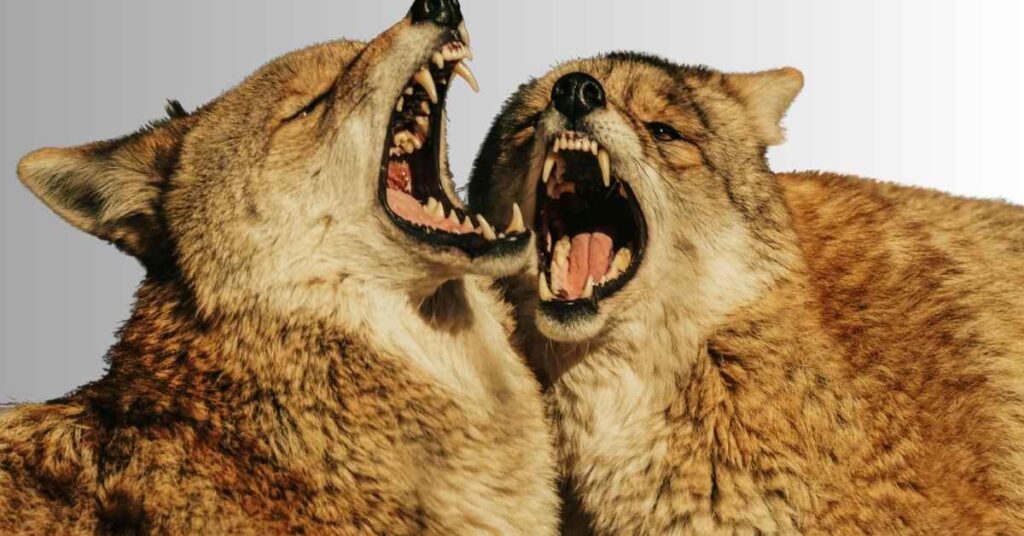Dog growling can stop you in your tracks. You’re relaxing on the couch when suddenly your beloved companion lets out a low, rumbling growl. Your heart skips a beat—is something wrong? Should you be worried? If you’ve ever experienced this moment of uncertainty, you’re not alone. Many dog owners find themselves puzzled when their furry friend starts making this distinctive sound.
Understanding dog growling is essential for every pet owner. While some people automatically assume a growling dog is aggressive or dangerous, the reality is far more nuanced. Dogs use growls to express a wide range of emotions and needs—from playful excitement to genuine concern. This guide covers everything you need to know about why dogs growl and how to respond appropriately.
What Is Dog Growling?
Dog growling is a form of vocal communication that dogs use to express their feelings and intentions. Think of it as your dog’s way of talking to you and others around them. When you hear that distinctive rumbling sound that seems to come from deep in their chest, your dog is sending a message.
Different types of growls serve different purposes. A playful growl sounds lighter and may come with a wagging tail and relaxed body. A warning growl tends to be deeper and more sustained, often accompanied by tense body language. Some dogs even produce conversational growls during happy moments, like when you come home from work.
The growl’s meaning depends heavily on context. A growl during tug-of-war usually signals excitement and engagement. A growl when someone approaches their food bowl typically indicates resource guarding. Learning to interpret these vocal cues helps you understand what your dog is trying to communicate.
Dogs produce growls using their vocal cords by pushing air from their lungs through partially closed vocal cords, creating vibrations that produce the characteristic rumbling sound. Body language plays a crucial role alongside the vocalization itself. A dog might pull back their lips, show teeth, stiffen their body, or raise their hackles. These physical signals work together with the auditory growl to convey the complete message.
Why Do Dogs Growl? Common Reasons
Fear and Anxiety When dogs feel scared or uncertain, they may growl as a way to say “please back off” before the situation escalates. This defensive growl serves as an important warning signal that should always be respected.
Territorial Behavior Dogs naturally protect their space, and growling helps them establish boundaries. Resource guarding—protecting food, toys, or favorite spots—also triggers growls. This instinctive behavior stems from survival mechanisms, even in well-fed domestic dogs.
Pain or Discomfort A dog experiencing physical distress might growl when touched in a sensitive area. If your dog suddenly starts growling when handled, especially in areas they previously didn’t mind being touched, a veterinary checkup is essential.
Warning Signals Dogs use growls as general warning signals when they sense something amiss in their environment. This could be an unfamiliar sound, smell, or sight that makes them uncomfortable.
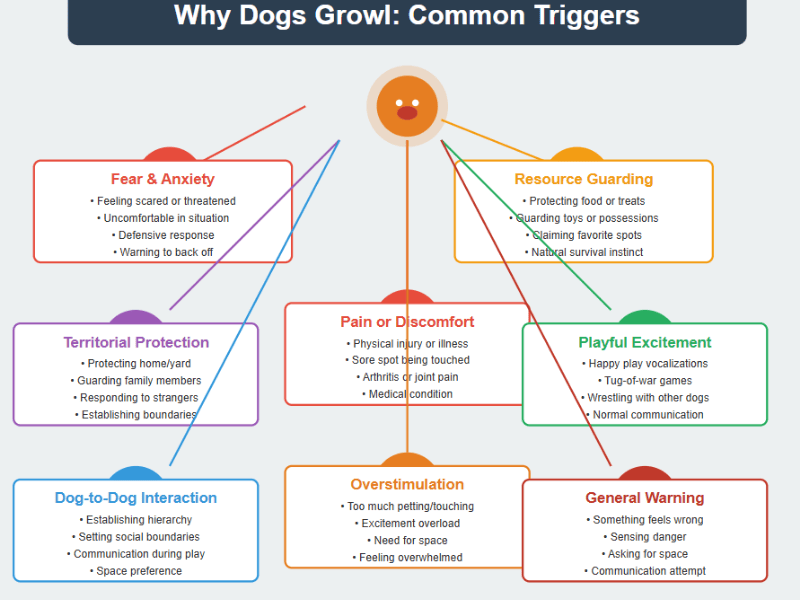
Why Does My Dog Growl at Me?
This situation can feel personally troubling, but remember—growling at owners isn’t necessarily about dominance or disrespect. Context matters enormously:
- Did you approach while they were sleeping? Dogs startled from sleep sometimes growl reflexively.
- Were you reaching for their toy or food? Resource guarding can direct itself toward anyone, including beloved owners.
- Did you try to move them off furniture? Some dogs have learned to claim certain spaces as their own.
- Were you handling them in a way that caused discomfort?
Understanding the trigger requires honest assessment of the situation. Consider what happened immediately before the growl. What were you doing? Where was your dog? What else was happening in the environment? These details help identify the cause.
Why Does My Dog Growl at “Nothing”?
The truth is, there’s always a reason—even when we can’t immediately identify it. Dogs don’t growl randomly. Something in their environment or internal state prompted the response.
Hidden triggers include subtle environmental changes. Maybe your dog heard a noise you missed. Perhaps they smelled something unusual. Dogs have far more sensitive hearing and smell than humans, so what seems like nothing to you might be quite significant to them.
Why Does My Dog Growl at Other Dogs?
Social dynamics between dogs are complex. Several factors influence dog-to-dog interactions. Some dogs feel uncomfortable with unfamiliar canines in their space. Others have learned that growling creates distance when they feel overwhelmed.
This behavior might indicate poor socialization, past negative experiences, or simply personality differences. Some dogs prefer their own space and use growls to communicate that preference. This doesn’t necessarily mean aggression—just a request for boundaries.
Dogs growling at each other during initial meetings is quite common. They’re establishing social hierarchies and personal space. Many dogs work through these moments naturally with appropriate body language and vocalizations.
Why Does My Dog Growl at Strangers?
Protective instincts explain much of this behavior. When a dog growls at strangers, they’re often acting as guardians of their family or territory. This behavior stems from the dog’s natural desire to keep their pack safe from potential threats.
From your dog’s perspective, unknown people represent potential dangers until proven otherwise. Some dogs are naturally more cautious than others, making them more likely to growl at unfamiliar faces. This behavior becomes more pronounced if the stranger enters what the dog considers their territory—your home, yard, or car.
Play Growling vs. Aggressive Growling
Do Dogs Growl When Playing?
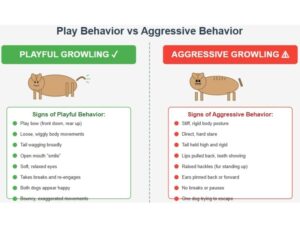
Yes! Play growling is completely normal and healthy. Many dog owners worry unnecessarily when they hear growls during playtime, but this vocalization is actually a sign of engagement and excitement.
Dogs growl when playing because they’re having fun and communicating enthusiasm. Just like humans might laugh or shout during games, dogs vocalize during play. These play growls sound different from warning growls—they’re usually higher-pitched, shorter, and accompanied by clearly playful body language.
Signs of healthy play behavior include frequent position changes, play bows (front end down, rear end up), loose wiggly body movements, and taking turns being “in charge” of the game.
Understanding the Difference
Body language cues during play tell you everything you need to know:
Playful Growling Signs:
- Relaxed faces and open mouths that look like smiles
- Soft eyes
- Tails wagging broadly
- Bouncing around with loose, fluid movements
- Both participants enjoying themselves
- Natural breaks with willing re-engagement
- Reciprocal and balanced interaction
Warning Growling Signs:
- Stiffening body
- Direct, hard stares
- Raised hackles
- Tails held high and rigid
- Deeper, more sustained growls
- One participant is trying to escape
- Increasing intensity without breaks
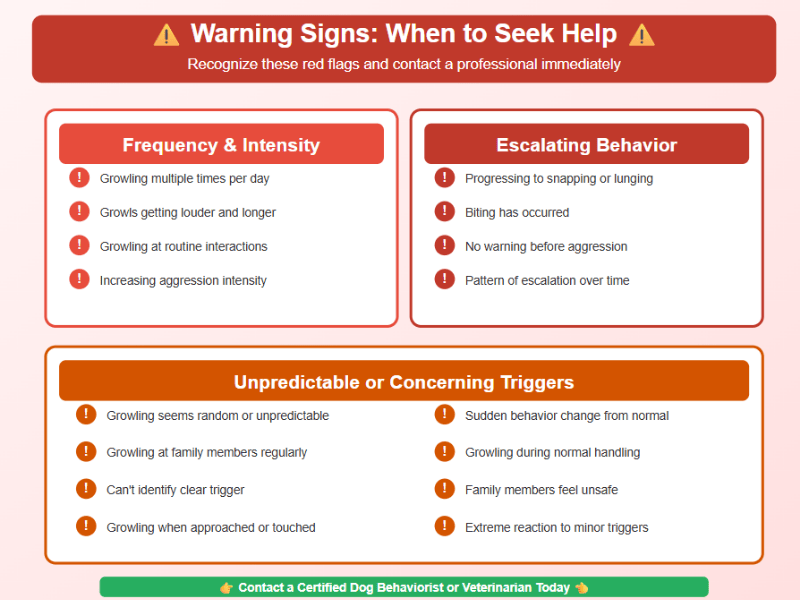
When play growling escalates into true conflict, the body language shifts dramatically. However, in typical play sessions, growling remains light and fun.
Is Play Growling Normal?
When play growling is healthy, you’ll observe several key indicators. Both dogs (or dog and human) appear to be enjoying themselves. Breaks happen naturally, and both parties willingly re-engage. The intensity remains consistent rather than escalating. Each participant can walk away without the other pursuing aggressively.
Red flags to watch for include one dog persistently trying to escape, hiding, or showing fearful body language. If one participant becomes increasingly aroused or intense while the other becomes more submissive or frightened, it’s time to interrupt. True play is reciprocal and balanced.
Dogs can growl when happy, especially during play and sometimes during greeting rituals or when being petted. These happy growls sound distinctly different from warning growls—they’re softer, shorter, and accompanied by obvious contentment signals like relaxed posture and wagging tails.
Puppy Growling: What to Know
Puppy growling is a normal part of development. Young dogs learn about communication, boundaries, and social interaction through vocalization and play. Puppies experiment with different sounds, including growls, as they figure out how to express themselves.
Development stages include periods where puppies test boundaries extensively. They’re not being deliberately difficult—they’re learning about cause and effect. A growling puppy is discovering that certain vocalizations produce specific responses from humans and other animals.
The connection between teething and growling is real. Puppies experiencing mouth discomfort may growl more frequently, especially when objects touch their sensitive gums. This doesn’t indicate aggression—just discomfort combined with normal puppy behavior.
Why Is My Puppy Growling at Me?
Common puppy behavior includes occasional growling during play, handling, or when tired. Puppies often growl playfully when tugging toys or wrestling. These are training opportunities where you can teach appropriate responses.
When your puppy growls, you can teach them that their communication is heard and respected. If the growl is playful and acceptable, continue the interaction. If it signals discomfort or overstimulation, pause the activity and give your puppy space.
Puppies growl because they’re exploring their vocal repertoire and learning what works. They watch how you respond and adjust their behavior accordingly. Consistent, patient responses help shape appropriate communication patterns.
When to Be Concerned
A puppy growling during play is different from a puppy displaying rigid body language, hard stares, and sustained growling when approached. The former is normal; the latter needs professional guidance.
Early intervention is crucial. If you notice concerning patterns—like your puppy growling intensely when handled, showing signs of fear aggression, or responding with stiff, threatening body language—consult a professional trainer or veterinary behaviorist promptly. Early socialization and training prevent many future behavior problems.
What to Do If Your Dog Growls at You
Immediate Response
Stay Calm and Never Punish Growling. This is crucial—punishment doesn’t eliminate the feeling causing the growl; it only suppresses the warning. A dog who learns not to growl may skip straight to biting without giving any warning signal.
Give Space Immediately. Step back and create distance between you and your dog. This respects their communication and prevents escalation. Even if you feel the growl was “unreasonable,” responding with space maintains safety and trust.
Assess the Trigger: What were you doing when the growl occurred? What was your dog doing? Where were you both located? Understanding the trigger helps prevent similar situations in the future.
Step-by-Step Guide
- Stop what you’re doing – If you were reaching for something, pulling your dog, or performing any action, cease immediately.
- Back away slowly – Avoid sudden movements or running, which might trigger chase instincts.
- Remove the trigger if possible – If your dog growled because someone approached their food bowl, have everyone move away from the feeding area.
- Observe body language carefully – Is your dog relaxing now that you’ve backed off? Or do they still appear tense and agitated?
- Consult a professional if needed – If growling becomes frequent, seems unpredictable, or you feel uncertain about safety, reach out to a certified dog behaviorist or trainer.
Long-term Solutions
Building trust requires consistency and respect. When you respond appropriately to growling, you strengthen your relationship. Over time, your dog learns that their communication is heard and respected, which actually reduces the need for growling.
Positive reinforcement training teaches alternative behaviors and builds positive associations. Instead of punishing unwanted growling, reward calm behavior and appropriate responses to triggers. This approach addresses root causes rather than just suppressing symptoms.
Professional help becomes necessary when growling patterns concern you or when you’re unsure how to proceed. A qualified behaviorist can assess your specific situation and develop a customized training plan. Don’t wait until a bite occurs—proactive intervention prevents serious problems.
How to Address Growling: The Right Approach
Don’t Suppress Warning Signals
Growling serves as an important communication tool that prevents more serious aggression. When you punish a dog for growling, they may learn to skip the warning and proceed directly to biting.
The goal isn’t to stop dog growling itself—it’s to resolve whatever issue makes your dog feel the need to growl. When underlying problems are fixed, growling naturally decreases.
Identify Triggers First
Keep a journal noting when, where, and why your dog growls. Patterns will emerge, showing you what situations prompt the behavior. This information is invaluable for developing an effective training plan.
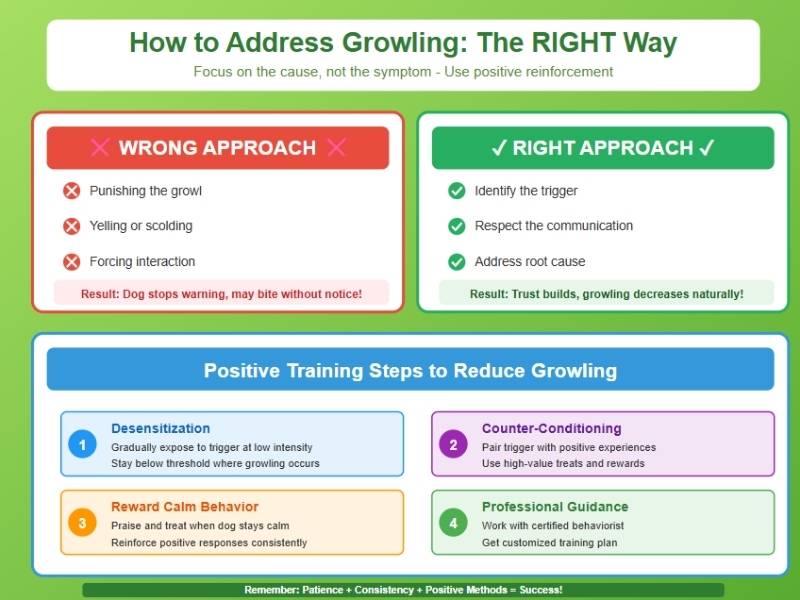
Desensitization and Counter-Conditioning
Desensitization involves gradual, controlled exposure to triggers at a low intensity that doesn’t provoke growling. Slowly, over many sessions, you increase exposure while keeping your dog comfortable.
Counter-conditioning pairs trigger exposure with positive experiences. If your dog growls at strangers, you might practice having strangers toss treats from a distance. Over time, strangers become associated with good things rather than threats.
Addressing Specific Situations
Growling at People, Socialization techniques help dogs become comfortable around various people. Proper socialization involves positive exposure to different ages, sizes, and types of people in controlled settings.
Start with people at a distance where your dog remains calm. Reward relaxed behavior. Gradually decrease the distance over many sessions, always staying within your dog’s comfort zone.
Growling at Family Members: Household dynamics sometimes create tension. Make sure all family members handle the dog consistently and respect their boundaries. Mixed messages confuse dogs and can increase growling.
If your dog growls when disturbed while eating or sleeping, the solution is simple: don’t disturb them during these times. As trust builds, you can gradually work on these specific situations through training.
Growling at Other Dogs. Dog-to-dog socialization requires careful management. Controlled exposure with well-socialized dogs in neutral settings helps your dog learn appropriate interaction skills.
Reward-based training makes positive interactions with other dogs valuable. When your dog remains calm around other dogs, they receive treats, praise, or play. This creates motivation to control their impulses.
Expert Tips
Professional behaviorist consultation provides tailored solutions. Every dog is unique, and what works for one may not work for another. Expert assessment ensures you’re addressing your dog’s specific issues effectively.
Patience and consistency are non-negotiable. Behavior modification takes time. Expecting overnight changes leads to frustration. Commit to the process and celebrate small improvements along the way.
When Dog Growling Becomes a Concern
Warning Signs
Frequency and intensity matter. Occasionally, context-appropriate growling is normal. Frequent growling throughout the day, in response to routine interactions, or with increasing intensity, indicates a problem requiring professional intervention.
Escalating behavior is a red flag. If growling becomes louder, longer, or progresses to snapping or biting, immediate professional help is necessary. This escalation pattern won’t resolve on its own.
Unpredictable triggers create safety concerns. When you can’t identify why your dog growls or when growling seems random, a professional assessment becomes crucial.
When to Seek Professional Help
Certified dog behaviorists specialize in modifying problem behaviors. Look for credentials like CAAB (Certified Applied Animal Behaviorist) or DACVB (Diplomate of the American College of Veterinary Behavior).
Veterinary consultation rules out medical causes. Pain, neurological issues, and other health problems can trigger sudden behavior changes. Your vet can examine your dog and recommend specialists if needed.
Training programs provide ongoing support and structure. Group classes work well for some dogs, while others benefit from private sessions.
Conclusion
Dogs’ growling is communication, not defiance. Throughout this guide, we’ve explored the many reasons dogs use growls to express themselves—from playful excitement to serious warnings. Understanding leads to better relationships built on trust and mutual respect.
The key takeaways are clear: never punish growling, pay attention to context and body language, and address underlying causes rather than suppressing symptoms. Whether dealing with puppy growling, play behavior, or concerning patterns, the solution always involves understanding what your dog is trying to tell you.
Remember that a growling dog is a communicating dog—and that’s actually a good thing. When dogs stop growling, they haven’t necessarily become more comfortable; they may have simply learned to skip warnings and proceed directly to biting.
Encourage responsible dog ownership by learning your dog’s individual communication style, respecting their boundaries, and investing in proper training and socialization. Your dog depends on you to understand their needs and keep them feeling safe and secure. When you master the language of dog growls, you strengthen your bond and create a happier, healthier relationship for years to come.

